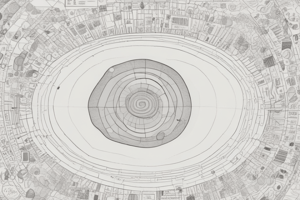Podcast
Questions and Answers
¿Qué es la transferencia de datos?
¿Qué es la transferencia de datos?
- El proceso de eliminar información de un dispositivo.
- El proceso de enviar información de un dispositivo a otro. (correct)
- El proceso de cifrar información en un dispositivo.
- El proceso de almacenar información en un dispositivo.
¿Cuál es la diferencia entre la transferencia activa y las interrupciones?
¿Cuál es la diferencia entre la transferencia activa y las interrupciones?
- La transferencia activa y las interrupciones no son posibles.
- La transferencia activa mantiene al procesador ocupado verificando el estado del controlador, mientras que las interrupciones permiten que el proceso se suspenda hasta que se notifique la finalización. (correct)
- La transferencia activa y las interrupciones son lo mismo.
- La transferencia activa permite que el proceso se suspenda hasta que se notifique la finalización, mientras que las interrupciones mantienen al procesador ocupado verificando el estado del controlador.
¿Cuáles son los problemas con las interrupciones?
¿Cuáles son los problemas con las interrupciones?
- Retraso del proceso y pérdida de datos.
- Aceleración del proceso y posibles conflictos de interrupción.
- Retraso del proceso y posibles conflictos de interrupción. (correct)
- Aceleración del proceso y pérdida de datos.
¿Qué es la multiprogramación?
¿Qué es la multiprogramación?
¿Cuál es más eficiente, la transferencia activa o las interrupciones?
¿Cuál es más eficiente, la transferencia activa o las interrupciones?
¿Por qué las operaciones de entrada/salida (E/S) son más lentas que la ejecución de procesos?
¿Por qué las operaciones de entrada/salida (E/S) son más lentas que la ejecución de procesos?
¿Qué son los buffers y para qué se utilizan?
¿Qué son los buffers y para qué se utilizan?
Flashcards are hidden until you start studying
Study Notes
- Data transfer can be done actively or through interrupts
- Active transfer keeps the processor busy checking the status of the controller
- Interrupts allow the process to be suspended until notified of completion
- Interrupts improve performance but lead to process delay
- Two problems with interrupts: process delay and potential interruption conflicts
- Active transfer hinders multiprogramming
- Interrupts allow for multiprogramming
- Interrupts improve efficiency
- Active transfer is less efficient
- Interrupts have some drawbacks but are generally preferable for data transfer
- Input/output (I/O) operations are slower than process execution.
- Data exchanged with peripheral devices must be read or written to the process's main memory address space, making it impossible to fully eject the process.
- Buffers are commonly used to solve this problem.
- Buffers provide benefits such as adapting speeds, adapting data sizes, and ensuring data integrity.
- Buffers can improve performance by offloading certain I/O operations from the processor.
- There are three main techniques for implementing buffers: single buffer, double buffer, and circular buffer.
- The system operating system must balance efficiency and generality when designing I/O functionality.
- Homogenization of I/O operations is possible through the use of specific drivers for each device.
- Standardization of driver interfaces simplifies system operating system design.
- Driver programmers must follow conventions and provide necessary services to the system operating system.
Studying That Suits You
Use AI to generate personalized quizzes and flashcards to suit your learning preferences.




